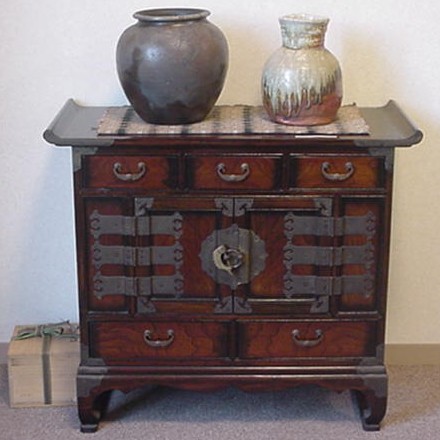|
Some Tips on Displaying Pottery
One of the joys of living with fine pieces of ceramic art is displaying them in the home. A tea cup or chawan (tea bowl) are wonderful to use but also, in some cases, are a pleasure to gaze upon. The same can be said for most other forms as well. Of course the Japanese have a special place to display art, that being the tokonoma or alcove. Unfortunately, most Japanese have forgotten what that special, sacred space is all about. Many are not used for contemplative art anymore but as places for televisions and clothing chests. Yet, there are still some folks around with an aesthetic sense who use their tokonoma artistically and spiritually.
Other display places are the wonderful wooden chests that Japan is famous for. Yet, it is Korean chests that you'll find most pottery collectors showing their treasures on. The lines are cleaner and without much of the beautiful, yet distractive, metalwork found on Japanese chests.
 |
Another way to enjoy displaying pottery is to have the works sit on varied cloths or pieces of wood. Even a kitchen counter will change the personality of a pot. I find that a work will show another side when placed on different items. I've seen that not only in my own home but also at galleries and collector's homes as well.
To illustrate the point, I've taken numerous photos of Matsuzaki Ken's ash-glazed square bottle (see below). Upon each different item on which I placed it, the work showed a slightly different temperament. Sometimes it looked stately, a bit proud, with an air of sophistication. While upon another item, like a piece of wood, it was more humble, approachable, and down-to-earth. The point is simple - using any suitable material as a base helps to compliment or highlight different colors on a pot.
Click Photo for Larger Image
|
Alone |
Straw Mat |
Wood |
|
Cloth |
Cloth |
Tray |
|
Cloth |
Shelf |
Wood |
|
Cloth |
Wood |
Wood |
|
Wood |
all photos by Robert Yellin
|
|
The pieces of wood pictured above are nothing out of the ordinary, one I found washed up on the shore of Suruga Bay, and another is a board from a local hardware store. Nothing fancy. Some of the cloth items are old kimono fabrics, or weaved silk brocades sold at teashops here. I'm sure that many other things would work as well; large leaves, cut-up denim, an old porch plank. Play around and see what kind of display you can create, placing the work juxtaposed with another, or next to a painting, or on some odd item found in the attic. I'm sure you'll discover a new personality to the pot you thought you knew. Plus, as part of the path to becoming a chajin - an aesthetically refined person of Tea taste - one must take a playful, yet serious approach to the display of art, whether it be a fine pot, or a simple stone. So Enjoy - and Experiment !
|